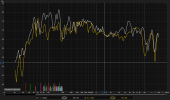Hey all - as the heading says I'm looking for some help diagnosing an issue with my set up / new room.
I've recently moved into a large open concept industrial loft with cement floors and 12 ft tall cement ceilings. The area my system is set up in is approx 850 sqf and its sounding under powered with very lean low end. This was not an issue in my previous home where my living room was approx 350 sqf. Now I need to play the amp to at least 50% to get only 'ok' low end out of the speakers which is not a comfortable for casual listening.
I'm running a Wiim Amp and a pair of Elac Debut 2.0 DF52 floorstanding speakers. Despite this being an entry level set up, it sounded awesome in my previous home. I'm going to add a few extra rugs to the room as well as 6 - 8 acoustic panels (2" x 24" x 48" mineral wool) to the wall behind the speakers, the ceiling above the sofa, and the rear wall to help with the reverb in this place (which is bad). This is the best I can do since I live in the loft and don't want it looking like a recording studio.
Some questions:
- Is it sounding under powered because of the reverb?
- Will the acoustic panels help with the low end?
- If the panels don't help with low end, is my only option adding a sub? or can larger speakers (ie. 8" drivers instead of 5.25") help by pushing more air?
Notes:
- Basic floor plan is attached is to scale and doesn't show any of the other rugs/furniture in the room. Yes the set up location in is not ideal but it's all I have to work with.
- REW SPL graph of my set up in the new room is smoothed to 1/12.
Any help would be greatly appreciated.
Thank you!
I've recently moved into a large open concept industrial loft with cement floors and 12 ft tall cement ceilings. The area my system is set up in is approx 850 sqf and its sounding under powered with very lean low end. This was not an issue in my previous home where my living room was approx 350 sqf. Now I need to play the amp to at least 50% to get only 'ok' low end out of the speakers which is not a comfortable for casual listening.
I'm running a Wiim Amp and a pair of Elac Debut 2.0 DF52 floorstanding speakers. Despite this being an entry level set up, it sounded awesome in my previous home. I'm going to add a few extra rugs to the room as well as 6 - 8 acoustic panels (2" x 24" x 48" mineral wool) to the wall behind the speakers, the ceiling above the sofa, and the rear wall to help with the reverb in this place (which is bad). This is the best I can do since I live in the loft and don't want it looking like a recording studio.
Some questions:
- Is it sounding under powered because of the reverb?
- Will the acoustic panels help with the low end?
- If the panels don't help with low end, is my only option adding a sub? or can larger speakers (ie. 8" drivers instead of 5.25") help by pushing more air?
Notes:
- Basic floor plan is attached is to scale and doesn't show any of the other rugs/furniture in the room. Yes the set up location in is not ideal but it's all I have to work with.
- REW SPL graph of my set up in the new room is smoothed to 1/12.
Any help would be greatly appreciated.
Thank you!


